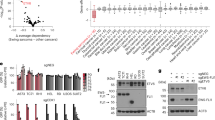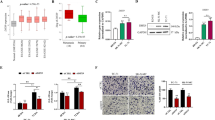Abstract
Ewing sarcoma provides an important model for transcription-factor-mediated oncogenic transformation because of its reliance on the ETS-type fusion oncoprotein EWS/FLI. EWS/FLI functions as a transcriptional activator and transcriptional activation is required for its oncogenic activity. Here, we demonstrate that a previously less-well characterized transcriptional repressive function of the EWS/FLI fusion is also required for the transformed phenotype of Ewing sarcoma. Through comparison of EWS/FLI transcriptional profiling and genome-wide localization data, we define the complement of EWS/FLI direct downregulated target genes. We demonstrate that LOX is a previously undescribed EWS/FLI-repressed target that inhibits the transformed phenotype of Ewing sarcoma cells. Mechanistic studies demonstrate that the NuRD co-repressor complex interacts with EWS/FLI, and that its associated histone deacetylase and LSD1 activities contribute to the repressive function. Taken together, these data reveal a previously unknown molecular function for EWS/FLI, demonstrate a more highly coordinated oncogenic transcriptional hierarchy mediated by EWS/FLI than previously suspected, and implicate a new paradigm for therapeutic intervention aimed at controlling NuRD activity in Ewing sarcoma tumors.
This is a preview of subscription content, access via your institution
Access options
Subscribe to this journal
Receive 50 print issues and online access
$259.00 per year
only $5.18 per issue
Buy this article
- Purchase on Springer Link
- Instant access to full article PDF
Prices may be subject to local taxes which are calculated during checkout







Similar content being viewed by others
References
Delattre O, Zucman J, Plougastel B, Desmaze C, Melot T, Peter M et al. Gene fusion with an ETS DNA-binding domain caused by chromosome translocation in human tumours. Nature 1992; 359: 162–165.
May WA, Lessnick SL, Braun BS, Klemsz M, Lewis BC, Lunsford LB et al. The Ewing's sarcoma EWS/FLI-1 fusion gene encodes a more potent transcriptional activator and is a more powerful transforming gene than FLI-1. Mol Cell Biol 1993; 13: 7393–7398.
Seth A, Watson DK . ETS transcription factors and their emerging roles in human cancer. Eur J Cancer 2005; 41: 2462–2478.
Petermann R, Mossier BM, Aryee DN, Khazak V, Golemis EA, Kovar H . Oncogenic EWS-Fli1 interacts with hsRPB7, a subunit of human RNA polymerase II. Oncogene 1998; 17: 603–610.
Ramakrishnan R, Fujimura Y, Zou JP, Liu F, Lee L, Rao VN et al. Role of protein-protein interactions in the antiapoptotic function of EWS-Fli-1. Oncogene 2004; 23: 7087–7094.
Lessnick SL, Braun BS, Denny CT, May WA . Multiple domains mediate transformation by the Ewing's sarcoma EWS/FLI- 1 fusion gene. Oncogene 1995; 10: 423–431.
Smith R, Owen LA, Trem DJ, Wong JS, Whangbo JS, Golub TR et al. Expression profiling of EWS/FLI identifies NKX2.2 as a critical target gene in Ewing's sarcoma. Cancer Cell 2006; 9: 405–416.
Prieur A, Tirode F, Cohen P, Delattre O . EWS/FLI-1 silencing and gene profiling of Ewing cells reveal downstream oncogenic pathways and a crucial role for repression of insulin-like growth factor binding protein 3. Mol Cell Biol 2004; 24: 7275–7283.
Owen LA, Kowalewski AA, Lessnick SL . EWS/FLI mediates transcriptional repression via NKX2.2 during oncogenic transformation in Ewing's sarcoma. PLoS ONE 2008; 3: e1965.
Kinsey M, Smith R, Iyer AK, McCabe ER, Lessnick SL . EWS/FLI and its downstream target NR0B1 interact directly to modulate transcription and oncogenesis in Ewing's sarcoma. Cancer Res 2009; 69: 9047–9055.
Hahm KB, Cho K, Lee C, Im YH, Chang J, Choi SG et al. Repression of the gene encoding the TGF-beta type II receptor is a major target of the EWS-FLI1 oncoprotein. Nat Genet 1999; 23: 222–227.
Gangwal K, Sankar S, Hollenhorst PC, Kinsey M, Haroldsen SC, Shah AA et al. Microsatellites as EWS/FLI response elements in Ewing's sarcoma. Proc Natl Acad Sci USA 2008; 105: 10149–10154.
Schaefer KL, Eisenacher M, Braun Y, Brachwitz K, Wai DH, Dirksen U et al. Microarray analysis of Ewing's sarcoma family of tumours reveals characteristic gene expression signatures associated with metastasis and resistance to chemotherapy. Eur J Cancer 2008; 44: 699–709.
Kauer M, Ban J, Kofler R, Walker B, Davis S, Meltzer P et al. A molecular function map of Ewing's sarcoma. PLoS ONE 2009; 4: e5415.
Bailly RA, Bosselut R, Zucman J, Cormier F, Delattre O, Roussel M et al. DNA-binding and transcriptional activation properties of the EWS-FLI-1 fusion protein resulting from the t(11;22) translocation in Ewing sarcoma. Mol Cell Biol 1994; 14: 3230–3241.
Arvand A, Welford SM, Teitell MA, Denny CT . The COOH-terminal domain of FLI-1 is necessary for full tumorigenesis and transcriptional modulation by EWS/FLI-1. Cancer Res 2001; 61: 5311–5317.
May WA, Gishizky ML, Lessnick SL, Lunsford LB, Lewis BC, Delattre O et al. Ewing sarcoma 11;22 translocation produces a chimeric transcription factor that requires the DNA-binding domain encoded by FLI1 for transformation. Proc Natl Acad Sci USA 1993; 90: 5752–5756.
Braunreiter CL, Hancock JD, Coffin CM, Boucher KM, Lessnick SL . Expression of EWS-ETS fusions in NIH3T3 cells reveals significant differences to Ewing's sarcoma. Cell Cycle 2006; 5: 2753–2759.
Gangwal K, Lessnick SL . Microsatellites are EWS/FLI response elements: genomic "junk" is EWS/FLI's treasure. Cell Cycle 2008; 7: 3127–3132.
Hancock JD, Lessnick SL . A transcriptional profiling meta-analysis reveals a core EWS-FLI gene expression signature. Cell Cycle 2008; 7: 250–256.
Owen LA, Lessnick SL . Identification of target genes in their native cellular context: an analysis of EWS/FLI in Ewing's Sarcoma. Cell Cycle 2006; 5: 2049–2053.
Perissi V, Jepsen K, Glass CK, Rosenfeld MG . Deconstructing repression: evolving models of co-repressor action. Nat Rev Genet 2010; 11: 109–123.
Wang Y, Zhang H, Chen Y, Sun Y, Yang F, Yu W et al. LSD1 is a subunit of the NuRD complex and targets the metastasis programs in breast cancer. Cell 2009; 138: 660–672.
Hollenhorst PC, Ferris MW, Hull MA, Chae H, Kim S, Graves BJ . Oncogenic ETS proteins mimic activated RAS/MAPK signaling in prostate cells. Genes Dev 2011; 25: 2147–2157.
Barker HE, Cox TR, Erler JT . The rationale for targeting the LOX family in cancer. Nat Rev Cancer 2012; 12: 540–552.
Shukla N, Ameur N, Yilmaz I, Nafa K, Lau CY, Marchetti A et al. Oncogene mutation profiling of pediatric solid tumors reveals significant subsets of embryonal rhabdomyosarcoma and neuroblastoma with mutated genes in growth signaling pathways. Clin Cancer Res 2012; 18: 748–757.
Hollenhorst PC, Shah AA, Hopkins C, Graves BJ . Genome-wide analyses reveal properties of redundant and specific promoter occupancy within the ETS gene family. Genes Dev 2007; 21: 1882–1894.
Jaboin J, Wild J, Hamidi H, Khanna C, Kim CJ, Robey R et al. MS-27-275, an inhibitor of histone deacetylase, has marked in vitro and in vivo antitumor activity against pediatric solid tumors. Cancer Res 2002; 62: 6108–6115.
Keshelava N, Houghton PJ, Morton CL, Lock RB, Carol H, Keir ST et al. Initial testing (stage 1) of vorinostat (SAHA) by the pediatric preclinical testing program. Pediatr Blood Cancer 2009; 53: 505–508.
Bennani-Baiti IM, Machado I, Llombart-Bosch A, Kovar H . Lysine-specific demethylase 1 (LSD1/KDM1A/AOF2/BHC110) is expressed and is an epigenetic drug target in chondrosarcoma, Ewing's sarcoma, osteosarcoma, and rhabdomyosarcoma. Hum Pathol 2012; 43: 1300–1307.
Lessnick SL, Dacwag CS, Golub TR . The Ewing's sarcoma oncoprotein EWS/FLI induces a p53-dependent growth arrest in primary human fibroblasts. Cancer Cell 2002; 1: 393–401.
Kinsey M, Smith R, Lessnick SL . NR0B1 is required for the oncogenic phenotype mediated by EWS/FLI in Ewing's Sarcoma. Mol Cancer Res 2006; 4: 851–859.
Kim J, Cantor AB, Orkin SH, Wang J . Use of in vivo biotinylation to study protein-protein and protein-DNA interactions in mouse embryonic stem cells. Nat Protoc 2009; 4: 506–517.
Subramanian A, Tamayo P, Mootha VK, Mukherjee S, Ebert BL, Gillette MA et al. Gene set enrichment analysis: a knowledge-based approach for interpreting genome-wide expression profiles. Proc Natl Acad Sci USA 2005; 102: 15545–15550.
Acknowledgements
We thank Drs Cairns, Engel and Bhaskara for discussions and critical reading of this manuscript and members of the Lessnick laboratory, and Drs Denny and Ayer, for discussions and reagents. SS acknowledges support from the HHMI Med into Grad program at the University of Utah (U2M2G). This work was supported by NIH/NCI Grants R01 CA140394 (to SLL) and P30 CA042014 (to Huntsman Cancer Institute) and funding from Imaging Diagnostics and Therapeutics Program at Huntsman Cancer Institute (to Sunil Sharma).
Author information
Authors and Affiliations
Corresponding author
Ethics declarations
Competing interests
Sorna Venkataswamy, Hariprasad Vankayalapati, Steven L Warner, Sunil Sharma and David J Bearss filed United States patent application 61/523 801 on 08/15/2011: Substituted (E)-N'-(1-Phenylethylidene)Benzohydrazide Analogs as Histone Demethylase Inhibitors.
Additional information
Supplementary Information accompanies the paper on the Oncogene website
Rights and permissions
About this article
Cite this article
Sankar, S., Bell, R., Stephens, B. et al. Mechanism and relevance of EWS/FLI-mediated transcriptional repression in Ewing sarcoma. Oncogene 32, 5089–5100 (2013). https://doi.org/10.1038/onc.2012.525
Received:
Revised:
Accepted:
Published:
Issue Date:
DOI: https://doi.org/10.1038/onc.2012.525
Keywords
This article is cited by
-
The FLI portion of EWS/FLI contributes a transcriptional regulatory function that is distinct and separable from its DNA-binding function in Ewing sarcoma
Oncogene (2021)
-
Selective inhibition of HDAC6 regulates expression of the oncogenic driver EWSR1-FLI1 through the EWSR1 promoter in Ewing sarcoma
Oncogene (2021)
-
Precision medicine in Ewing sarcoma: a translational point of view
Clinical and Translational Oncology (2020)
-
Review: Ewing Sarcoma Predisposition
Pathology & Oncology Research (2020)
-
Epigenetic drug library screening identified an LSD1 inhibitor to target UTX-deficient cells for differentiation therapy
Signal Transduction and Targeted Therapy (2019)



